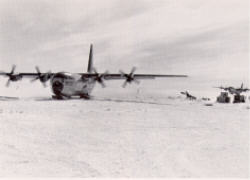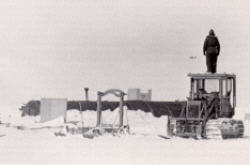|
Just before 11 pm (McMurdo local time) on 10 January 1988, the cloud-filled sky above Ross Island echoed with the sound of LC-130 airplane engines as two ski-equipped airplanes approached the ice-shelf runway and prepared to land. On the ice below a small group of civilian and U. S. military personnel waited expectantly for the airplanes to land. At 10:56 pm, the second airplane--Juliet Delta 321--landed safely on the glacier ice of the Ross Ice Shelf for the first time in 17 years. The airplane and its crew were greeted by the cheers of the welcoming crowd, many of whom had worked to retrieve the airplane during the last 3 years.
The airplane, which crashed in East Antarctica on 4 December 1971, had been buried in the snow for 15 years. Owned by the National Science Foundation (NSF), it is one of six LC-130 airplanes operated by the U.S. Navy Antarctic Development Squadron Six (VXE-6) as part of the NSF-managed U.S. Antarctic Program.

U.S. Navy photo by JO1 Dan Simon.
U.S. military and civilian personnel greet "321" pilot Commander Jack Rector, USN, commanding officer of the Antarctic Development Squadron 6, and the flight crew as they leave the airplane at Williams Field. |
Commander Jack Rector, the commanding officer of VXE-6, piloted the airplane during the 720 nautical mile (870 statute mile) trip to McMurdo from the isolated site at 68°20'5 137°20'E. Powered by four engines, three of which, along with the flight controls, were salvaged, refurbished, and reinstalled for The recovery mission, the LC-130 performed well throughout the 5-hour flight, according to Commander Rector. Because the airplane's communications system was only partially restored and none of its navigation equipment was reinstalled, a second LC-130, under the command of Lieutenant Commander Bradley Lanzer, escorted Juliet Delta 321 on the first leg of its homeward flight.
The recovery, which required 3 years of planning and field work, was a remarkable accomplishment not only because of the effort and dedication of the people who planned and worked to make the airplane capable of frying again but also because of the people who fervently supported the endeavor.
The LC-130, built by Lockheed's Georgia Corporation, is credited with revolutionizing scientific exploration in Antarctica. Nicknamed the "Workhorse of Antarctica," this airplane is a vital link in the complex logistic system required to support the U.S. research program on the southernmost continent. Like other airplanes, these airplanes can land on hard-surface and prepared ice runways, but because they are ski-equipped, they are able to land where wheeled airplanes cannot, on rough surfaces such as glacier ice and wind-marred snow. The U.S. Antarctic Program uses them to transport personnel, cargo, and supplies from McMurdo Station to all field sites and inland stations, as well as between Christchurch, New Zealand, and McMurdo Station.
On 4 December 1971, Juliet Delta 321 delivered supplies to a traverse team participating in the international Antarctic Glaciological Project on its way to the Soviet east Antarctic station Vostok. While taking off, two 165-pound, solid- fuel rockets (called JATO) broke loose Com their attachment points on the left rear fuselage and struck the number 2 engine, destroying the propeller and gear. Flying metal fragments from the engine, propeller, and gear damaged the number 1 engine. From an altitude of 50 feet, the pilot was forced to land the airplane. Although it landed safely and no one was injured, the emergency stop on the rough snow surface collapsed the main nose landing gear. Four days later, Navy investigators came to site, inspected the airplane, and decided that salvaging it would be too costly and dangerous.
 U.S. Navy photo by Pat Gilliand.
U.S. Navy photo by Pat Gilliand.
Juliet delta 321 prepares to take off from the east Antarctic site --known as D-59-- where it had been buried in the snow for 16 years. In the background the escort airplane begins its ascent. |
Following the successful recovery of three other damaged LC-130s from another isolated east Antarctic site, engineers recommended that Juliet Delta 321 be recovered. Because of budget and other program restrictions, NSF was not able to begin recovery efforts until 1985 when planning for the current project began. In November 1986 a team of six employees from ITT/Antarctic Services, Inc. --the NSF Antarctic support contractor-- made a 135-mile traverse from the coast to the site with the assistance of the French Antarctic program. When they arrived at the site, all that was visible of the airplane was the top 3 feet of the vertical stabilizer. The depth of snow from the surface to the landing gear was now more than 30 feet.
The men worked 10 to 12 hours each day, 7 days a week, for 1 month. On Christmas Day 1986, they towed the disabled airplane from the 33-foot excavation pit and parked it on the surface.
They found that the dry, cold Antarctic environment had preserved the airplane perfectly. By early January 1987, an inspection team had determined that the airplane was repairable. A VXE-6 maintenance team removed the four engines and three propellers and returned them to McMurdo for shipment to the Naval Aviation Depot (NAD) in Cherry Point, North Carolina, where they were repaired. (A full description of the recovery appears in the March/June 1987 issue of the Antarctic Journal of the United States.)

U.S. Navy photo by Pat Gilliand.
One of the people who worked to repair "321" in East Antarctica watches as the airplane begins its homeward journey. During November and December 1987, personnel from the Naval Aviation Depot in Cherry Point, North Carolina, and from Lockheed Georgia Corporation worked to prepare "321" for this flight. The airplane was retrieved from its icy tomb on 25 December 1986 by employees of ITT Antarctic Services Inc. (ITT ANS) and flown out by U.S. Navy personnel of the Antarctic Development Squadron 6 (VXE-6). |
In November 1987 a 17-man crew from NAD and Lockheed Georgia Corporation flew from McMurdo Station to the crash site and began repairs to ready the airplane for flight. They replaced the four rebuilt engines, propellers, and flight controls, as well as repaired the main nose gear, nose-gear landing struts, skis, instrumentation, and radome, They also repaired the airplane's left side where the propellers ripped through the hull and replaced other hull sections with specialty tempered metal.
During the 5 weeks required to repair the airplane, their work was often complicated by high winds, blowing snow, and temperatures that frequently dropped to -30°C (-22°F). More than once the small modular building and tent-like shelters that made up their camp were buried in snow by fierce storms. After another U.S. LC-130 crashed at site, killing two Navy passengers, the team redoubled its efforts. (See the March 1988 issue of the Antarctic Journal of the United States for details.)
On 8 January 1988 Mr. Jim Herman, the official inspector from NAD, certified that the airplane was ready. VXE-6 flight crews ran final tests. At 6:10 pm on 10 January, Juliet Delta 321 followed the escort into the air and headed toward McMurdo Station.
At Williams Field more repairs were made and a second inspection completed before the airplane took off on the next leg of its journey. After about 1 week Commander Rector flew "321" to Christchurch. Once in Christchurch, Air New Zealand, under a recently signed contract to the U.S. Antarctic Program, began to prepare the airplane for its flight back to the United States, where it will be taken to NAD in Cherry Point [NC] for final repairs.
The cost to recover and restore the airplane is less than one-third of the $35 million purchase price of a new, similarly equipped airplane. While "321" will return to Antarctic service, it will take several years before it is ready: In March 1989 a VXE-6 flight crew will fly the airplane to Cherry Point. In addition to being repaired, the airplane will be included in a special modification program that all USAP airplanes are undergoing. The purpose of this program is to upgrade the structure and avionics equipment of all LC-130s used by the United States to support Antarctic research. The U. S. program plans to begin using "321" in the Antarctic during the 1990-1991 austral summer.
|